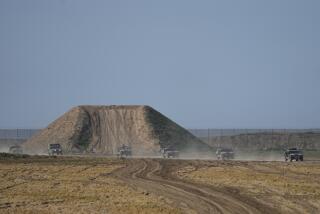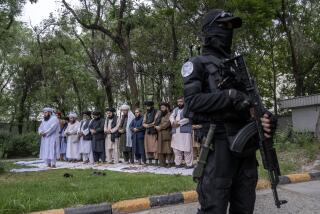U.S. Troops Aid Iraqi Soldiers in Baghdad Battle
- Share via
BAGHDAD — An hours-long gun battle in central Baghdad on Wednesday killed four Iraqi National Guard soldiers and injured 20 others. Members of the U.S. Army’s 1st Cavalry Division were called in to back up the besieged Iraqis, with Apache helicopters reportedly firing missiles into buildings.
The fighting began about 9 a.m. when a routine National Guard patrol traveling on the west side of the Tigris River near Haifa Street came under attack from small-arms fire, mortar rounds and rocket-propelled grenades.
“I couldn’t count them. They were shooting from every building,” one Iraqi soldier said. “It felt like the whole area turned against us.”
Elsewhere in Baghdad, mortar rounds struck near the headquarters of the Iraqi National Accord, the political party of Prime Minister Iyad Allawi. Six people reportedly were injured when four rounds landed in the Sadoun Street neighborhood, where Allawi lives.
Iraqi police also defused a large car bomb found along a central Baghdad street.
Allawi’s office released a statement suggesting that foreign fighters had a role in the attacks and calling for a united struggle against the insurgency.
“I would like to assure my people and the international community that these criminals will not only fail, they will crumble,” Allawi said. “I believe in Iraq, and I am confident that all Iraqis will unite to crush these foreign criminals that have illegally entered our country to hinder our progress and delay our development toward a united, safe and developing nation.”
The day’s events highlighted the diverse nature of the insurgency and the extent to which Iraq’s security forces remain dependent on U.S. military support.
The Iraqi National Guard, a paramilitary force created by U.S. administrators and originally called the Iraqi Civil Defense Corps, for the most part has worked alongside U.S. troops on patrols and raids. But since the transfer of power to Allawi’s government, the guardsmen have begun going solo on patrols.
Many of the soldiers and officers have expressed eagerness to show independence from their American patrons, arguing that the frequent attacks on Iraqi forces would then subside. But the National Guard soldiers still lack the equipment to deal with the kind of attack that occurred Wednesday. They are armed with semiautomatic weapons and travel in flatbed trucks, pickups or a few new jeeps.
“They’re using rockets. We don’t have any rockets,” one National Guard officer said.
Wednesday’s battle also pointed up logistical difficulties between the Iraqi and American forces. The National Guard officer said his unit had no way of directly contacting the U.S. military for backup. Instead they had to contact the Iraqi police, who notified the Americans.
By the time U.S. troops in Bradley fighting vehicles and a pair of low-flying Apache helicopters arrived, they found a big fight in progress, one U.S. soldier said. “But it dissipated quickly once the Apaches showed up.”
By early afternoon, a 1,100-yard stretch of Haifa Street had been sealed off by U.S. soldiers. The Apaches circled over rooftops in the distance, and thick smoke could be seen billowing from the neighborhood. At one point, a blue sedan carrying two men with scarves covering their faces came charging down the street, made a screeching U-turn and headed back toward the fighting.
U.S. soldiers conducted limited house-to-house raids and detained about a dozen suspects in the neighborhood.
Battles of this size are unusual in central Baghdad, but less-intense attacks on patrols are frequent.
Deposed Iraqi leader Saddam Hussein spent part of his childhood in the Karkh neighborhood around Haifa Street. The area is known as a stronghold for both criminal gangs and Hussein loyalists.
“We call Haifa Street the Street of Death,” a National Guard soldier said.
More to Read
Sign up for Essential California
The most important California stories and recommendations in your inbox every morning.
You may occasionally receive promotional content from the Los Angeles Times.









